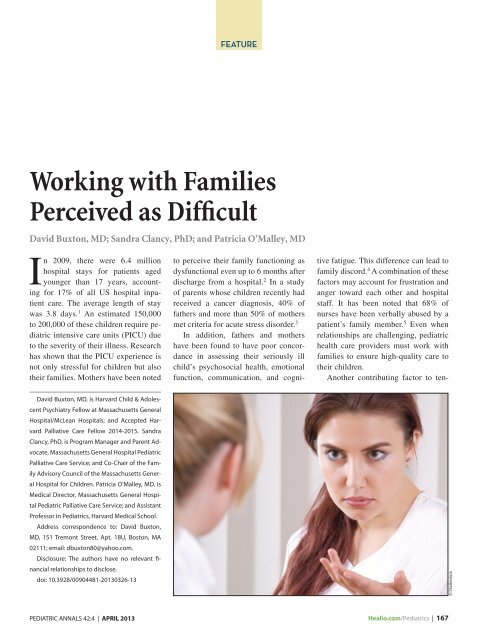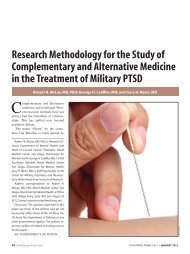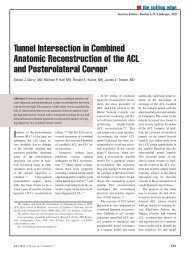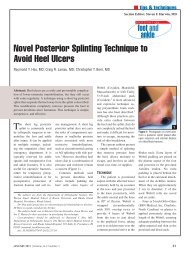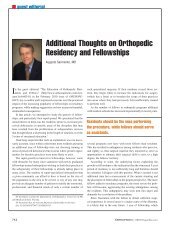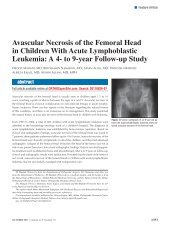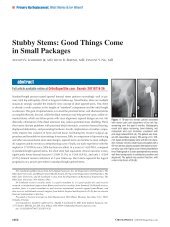View PDF - Healio
View PDF - Healio
View PDF - Healio
Create successful ePaper yourself
Turn your PDF publications into a flip-book with our unique Google optimized e-Paper software.
FEATURE<br />
Working with Families<br />
Perceived as Difficult<br />
David Buxton, MD; Sandra Clancy, PhD; and Patricia O’Malley, MD<br />
In 2009, there were 6.4 million<br />
hospital stays for patients aged<br />
younger than 17 years, accounting<br />
for 17% of all US hospital inpatient<br />
care. The average length of stay<br />
was 3.8 days. 1 An estimated 150,000<br />
to 200,000 of these children require pediatric<br />
intensive care units (PICU) due<br />
to the severity of their illness. Research<br />
has shown that the PICU experience is<br />
not only stressful for children but also<br />
their families. Mothers have been noted<br />
to perceive their family functioning as<br />
dysfunctional even up to 6 months after<br />
discharge from a hospital. 2 In a study<br />
of parents whose children recently had<br />
received a cancer diagnosis, 40% of<br />
fathers and more than 50% of mothers<br />
met criteria for acute stress disorder. 3<br />
In addition, fathers and mothers<br />
have been found to have poor concordance<br />
in assessing their seriously ill<br />
child’s psychosocial health, emotional<br />
function, communication, and cognitive<br />
fatigue. This difference can lead to<br />
family discord. 4 A combination of these<br />
factors may account for frustration and<br />
anger toward each other and hospital<br />
staff. It has been noted that 68% of<br />
nurses have been verbally abused by a<br />
patient’s family member. 5 Even when<br />
relationships are challenging, pediatric<br />
health care providers must work with<br />
families to ensure high-quality care to<br />
their children.<br />
Another contributing factor to ten-<br />
David Buxton, MD, is Harvard Child & Adolescent<br />
Psychiatry Fellow at Massachusetts General<br />
Hospital/McLean Hospitals; and Accepted Harvard<br />
Palliative Care Fellow 2014-2015. Sandra<br />
Clancy, PhD, is Program Manager and Parent Advocate,<br />
Massachusetts General Hospital Pediatric<br />
Palliative Care Service; and Co-Chair of the Family<br />
Advisory Council of the Massachusetts General<br />
Hospital for Children. Patricia O’Malley, MD, is<br />
Medical Director, Massachusetts General Hospital<br />
Pediatric Palliative Care Service; and Assistant<br />
Professor in Pediatrics, Harvard Medical School.<br />
Address correspondence to: David Buxton,<br />
MD, 151 Tremont Street, Apt. 18U, Boston, MA<br />
02111; email: dbuxton80@yahoo.com.<br />
Disclosure: The authors have no relevant financial<br />
relationships to disclose.<br />
doi: 10.3928/00904481-20130326-13<br />
© Shutterstock<br />
PEDIATRIC ANNALS 42:4 | APRIL 2013 <strong>Healio</strong>.com/Pediatrics | 167
FEATURE<br />
sion in the PICU is that the multidisciplinary<br />
team approach to inpatient pediatric<br />
medical care is often characterized<br />
by tight schedules, rotating team membership,<br />
and a range of departmental<br />
and institutional politics that can blur<br />
professional boundaries and impact<br />
care. 6 Lack of communication between<br />
care team members about patients can<br />
hamper collaboration and even lead to<br />
inadequate pain management. 7<br />
CASE PRESENTATION<br />
Natalie is an 11-year-old female with<br />
a medical history of poorly controlled<br />
asthma who had an asthma attack that<br />
led to a subsequent acute cardiac arrest<br />
at home. She was transferred to a tertiary<br />
hospital PICU from a rehabilitation<br />
facility several months after her cardiac<br />
arrest, for management of severe dysautonomia,<br />
or “storming,” and a persistent<br />
vegetative state.<br />
The patient’s family members, who<br />
were not fluent in English, included<br />
her mother and two aunts who provided<br />
Natalie with constant bedside attendance.<br />
They quickly began to voice<br />
anger at and distrust of Natalie’s medical<br />
team due to the rotating schedules<br />
of the PICU staff and subspecialists.<br />
Simultaneously, PICU staff expressed<br />
their frustration to each other at what<br />
they considered the family’s willful refusal<br />
to accept Natalie’s prognosis, as<br />
well as what was perceived as the family’s<br />
insistence on a miracle.<br />
Whenever Natalie’s symptoms escalated,<br />
family members would often become<br />
agitated. Their expressions of anger<br />
reduced several staff to tears; some<br />
even declined to be part of Natalie’s<br />
care team. Morning bedside rounds<br />
were often disrupted by family members’<br />
hostile and denigrating comments<br />
that heightened tension among house<br />
staff as Natalie’s potential for meaningful<br />
recovery was limited and her storming<br />
seemed to be uncontrollable.<br />
Natalie’s mother identified a few<br />
nurses whom she felt were “on our side”<br />
because they had allowed the family to<br />
adjust cooling blanket equipment and<br />
place an additional cot near Natalie’s<br />
bedside. Staff members who attempted<br />
to reset limits because of safety concerns<br />
were labeled by the family as “no<br />
good.” One morning during rounds,<br />
Natalie’s family demanded the patient<br />
be transferred after they had heard the<br />
term “persistent vegetative state” used<br />
by the team to describe Natalie’s condition;<br />
they declared that the patient’s<br />
care team could not treat her if they<br />
believed she was “a vegetable.” A team<br />
meeting was held to discuss the case.<br />
FACTORS IN ADVERSARIAL<br />
RELATIONSHIPS BETWEEN<br />
FAMILY AND CARE TEAM<br />
It is helpful for members of PICU<br />
care teams to meet and review a patient’s<br />
case in order to discuss issues<br />
that commonly contribute to difficult<br />
interactions. In Natalie’s case, her family<br />
was perceived as challenging for<br />
the care team for many reasons. Specifically,<br />
their restricted ability to communicate<br />
in English, cultural barriers,<br />
uncontrolled symptoms (storming),<br />
misunderstanding of treatment options,<br />
and extended stay in medical facilities<br />
contributed to a challenging environment<br />
for care.<br />
Sometimes there are contributing<br />
factors that interfere with optimal patient<br />
care (see Table 1). Many of these<br />
obstacles cannot be resolved by the<br />
treatment team; but identifying them<br />
as potential problems can help the care<br />
team — and the families — develop<br />
strategies and assist with locating the<br />
resources necessary to address them. In<br />
addition, awareness of these factors can<br />
facilitate more productive relationships<br />
with family members when diagnosis,<br />
prognosis, and treatment recommendations<br />
are discussed.<br />
TABLE 1.<br />
Confounding Care Factors<br />
• Language barriers<br />
• Cultural and religious differences<br />
• Acute onset of a child’s illness<br />
• Perception by a parent of the child’s suffering<br />
and pain level<br />
• Misunderstanding of treatment or<br />
diagnosis<br />
• Heightened physiologic stress on family<br />
of prolonged bedside care; includes deteriorating<br />
self-care (inadequate sleep, poor<br />
nutrition, inconsistent hygiene, etc)<br />
• Unclear etiology of child’s illness<br />
• Previous negative experiences with<br />
medical care<br />
• Multiple providers with poor communication<br />
amongst team members<br />
• Psychiatric illness amongst family<br />
members<br />
• Financial problems<br />
• Transportation issues<br />
POTENTIAL OBSTACLES TO CARE<br />
Bringing the entire patient team together<br />
can help create a more comprehensive<br />
portrait of a family and identify<br />
the potential conflicts to providing<br />
them with optimal care. In Natalie’s<br />
case, grief and difficulty accepting the<br />
likely outcome of the patient’s status<br />
were held by both the primary care<br />
team members and family alike; however,<br />
because there was a lack of communication,<br />
the family and members of<br />
the care team did not realize how much<br />
they had in common.<br />
To facilitate communication between<br />
Natalie’s family and care team,<br />
staff from the social work, chaplaincy,<br />
child life, child psychiatry, and pediatric<br />
palliative care departments were<br />
asked to become more involved in her<br />
treatment. The family was encouraged<br />
to contact specific primary medical<br />
staff members when they had a concern,<br />
and interpreter services were used<br />
to augment communication.<br />
168 | <strong>Healio</strong>.com/Pediatrics PEDIATRIC ANNALS 42:4 | APRIL 2013
FEATURE<br />
After this meeting, it became clear<br />
that the team needed a new focus that<br />
highlighted improving the family’s<br />
experience of care in areas not related<br />
specifically to Natalie’s medical treatment.<br />
A team captain was designated,<br />
and meetings with all team providers<br />
were held twice a week to ensure<br />
clear communication. The consulting<br />
services helped the care team and family<br />
explore and express their difficult<br />
emotions instead of acting on them in<br />
a destructive way. This process allowed<br />
Natalie’s family to begin grieving their<br />
loss while feeling supported.<br />
IMPORTANCE OF CLEAR<br />
COMMUNICATION<br />
Natalie’s initial team meeting was<br />
only the first step in forming an alliance<br />
to avoid conflict between staff and<br />
families. It is essential when working<br />
with families perceived as difficult for<br />
team members to make every effort to<br />
keep the message uniform and clear at<br />
all times. Families can interpret conflicting<br />
information from staff members<br />
as poor care or, even worse, incompetence.<br />
For example, in Natalie’s case,<br />
her continual storming led to a need for<br />
constant testing depending on her everchanging<br />
status; this was frustrating<br />
and confusing for her family.<br />
A useful strategy to ensure staff and<br />
families understand the current treatment<br />
plan is to hold multiple daily<br />
“team huddles.” These informal conversations<br />
can allow bidirectional communication<br />
among all parties and provide<br />
explanations about any confusing<br />
aspects of care. Staff should make an<br />
effort to enumerate what is currently<br />
being done for a patient, especially if<br />
the benefit is not apparent: for example,<br />
providing oxygen to ensure appropriate<br />
saturation rate, monitoring pulse and<br />
rhythm to check heart condition, etc.<br />
This is especially important if families<br />
articulate that “nothing is being done<br />
to address all the medical problems.” If<br />
a care plan changes, the daily meeting<br />
offers an opportunity to provide information<br />
to the family and reassure them<br />
that their concerns are being addressed.<br />
In addition, theses meetings can help<br />
clarify providers’ job descriptions so<br />
that parents can make the right choices<br />
about whom to present their specific<br />
concerns.<br />
ANTICIPATION OF<br />
COMMUNICATION DISRUPTIONS<br />
It is important to designate a “captain<br />
of the ship” to take charge of the<br />
treatment plan and facilitate conversations<br />
and decisions among providers.<br />
Staff should make an<br />
effort to enumerate what<br />
is currently being done for<br />
a patient, especially if the<br />
benefit is not apparent.<br />
In Natalie’s case, multiple consults<br />
were being conducted to help manage<br />
her difficult illness. Each specialist<br />
had a unique understanding of the nuances<br />
of Natalie’s illness; prior to the<br />
creation of the team meetings, these<br />
points of view were being articulated to<br />
her family whose medical comprehension<br />
was quite limited. Unfortunately,<br />
consults were then being reported to<br />
PICU team members who were rotating<br />
through service, leading to further<br />
confusion and frustration, especially on<br />
the family’s part. The ultimate blow to<br />
the family’s will to cooperate was when<br />
Natalie was described as being in “a<br />
persistent vegetative state.”<br />
This could have been avoided had<br />
Natalie’s treatment team discussed<br />
standardized terminology among<br />
themselves and the family. The lesson<br />
learned in this case was that by designating<br />
a “captain,” all medical information<br />
can be aimed at one person who<br />
can then interpret ongoing recommendations,<br />
appropriately direct care and<br />
ensure all providers understand the<br />
treatment plans.<br />
MINIMIZE ATTEMPTS TO “SPLIT”<br />
CARE TEAM<br />
Staff should be aware of a family’s<br />
attempts at “splitting” of caregivers.<br />
Natalie’s presentation demonstrates<br />
how conflict among providers and<br />
families can lead to negative outcomes<br />
such as staff being upset enough to request<br />
transfer off a patient’s case. A<br />
culture of conflict in which providers<br />
feel judged or inadequate can affect<br />
their ability to provide optimal care for<br />
a patient. Inherently, a split can arise<br />
between staff who agree to follow a<br />
family’s directives in order to avoid<br />
harsh treatment, and those who set<br />
limits despite any verbal abuse from<br />
the family. In Natalie’s case, if staff<br />
allowed the family control over her<br />
cooling blanket and a bedside cot, they<br />
were seen as “on our side,” but if they<br />
set limits were “no good.”<br />
To help minimize attempts to split<br />
the care team, “partnering up” with<br />
a colleague can help providers feel<br />
more supported when interacting with<br />
upset family members. This principle<br />
was especially important for Natalie’s<br />
care as it was noted her families’ agitation<br />
corresponded with her storming,<br />
which needed immediate attention by<br />
staff. By partnering up, one staff member<br />
can provide moral support for the<br />
provider administering care while simultaneously<br />
helping to calm family<br />
members.<br />
Splitting also can be prevented by<br />
having a clear strategy on how to deal<br />
with denigration of other team members,<br />
including expressing sympathy<br />
if things “did not go as well as hoped”<br />
PEDIATRIC ANNALS 42:4 | APRIL 2013 <strong>Healio</strong>.com/Pediatrics | 169
FEATURE<br />
while reinforcing respect for another<br />
team member’s capabilities to perform<br />
a duty. Staff can name and validate feelings<br />
of frustration, distress, and disappointment<br />
about an event without placing<br />
blame on anyone.<br />
TABLE 2.<br />
Summary of Family Caregiver Communication Strategies<br />
Strategy<br />
Explanation<br />
Clear Communication<br />
PROACTIVE APPROACH<br />
Another useful tool for staff is proactively<br />
to identify brewing questions or<br />
concerns from a family. Usually it is the<br />
nursing and nursing assistant staff that<br />
spends the greatest amount of time with<br />
a patient; they can alert other providers<br />
of perceived issues with treatment. If<br />
a family seems to have constant questions,<br />
it may help to establish structured<br />
times for questions or visits to minimize<br />
frequent or demanding inquiries. This<br />
plan can help the nursing staff manage<br />
families and minimize disruption from<br />
ongoing family requests.<br />
REINFORCE NATIVE PARENTING<br />
Finally, providers should support<br />
families in their native parenting roles.<br />
Because it can be difficult for parents to<br />
allow other people to perform daily routines<br />
with their children, it is helpful to<br />
encourage families to nurture and comfort<br />
as they would do in a nonmedical<br />
setting. If appropriate, staff can include<br />
them when providing basic care, such<br />
as changing diapers, bathing, and feeding.<br />
This collaboration can ease tension<br />
as parents feel part of the team instead<br />
of against it. To enhance the bond between<br />
providers and family, team members<br />
also can encourage parents to talk<br />
about their child’s personhood, asking<br />
parents to share photos of the child<br />
before hospitalization, what music the<br />
child likes, what stories they like, and<br />
so on. This process allows families and<br />
providers to ensure no one feels a child<br />
“is a vegetable.”<br />
SUPPORTIVE RESOURCES<br />
As established during Natalie’s team<br />
meeting, services that are not cure-<br />
“Captain of the ship”<br />
“Stay on the same page”<br />
“Who can answer that?”<br />
Minimize Conflict<br />
“Partner up”<br />
“Provide information<br />
about work”<br />
“Avoid the split”<br />
“Pre-emptive strikes”<br />
“Help the parents<br />
parent”<br />
Supportive Resources<br />
“Experience of care”<br />
“Care of the team”<br />
Identify one member of the team who can be a long-term<br />
contact providing continuity of care for consults, recommendations,<br />
and guidance of a treatment plan.<br />
Hold multiple daily “team huddles” to avoid miscommunication<br />
and ensure families are aware of changes in treatment<br />
decisions.<br />
A clear delineation of job descriptions for doctor, nurses, social<br />
workers, etc will help parents make the right choices about<br />
whom to present specific problems or questions.<br />
Partnering with a colleague when entering the room may<br />
minimize family behaviors that feel like an attack and provide<br />
moral support.<br />
Relay information to families about the work that is currently<br />
being done to care for the patient, even if it appears apparent.<br />
Avoid denigrating other team members by expressing sympathy<br />
for things that have not gone as well as hoped and by<br />
reinforcing to the family respect for all team members.<br />
Anticipatory calls and established structured times for questions<br />
or visits may help minimize frequent or demanding calls<br />
from families.<br />
Encourage families to care and comfort as they would do in<br />
a nonmedical setting. They are the keepers of their child’s<br />
personhood.<br />
Utilize all supportive services in the hospital, which may<br />
include social work, interpreter services, chaplaincy, child life,<br />
child psychiatry, and palliative care that focus on the experience<br />
of care.<br />
Ensure appropriate outlets for staff to express emotions to help<br />
foster resiliency and better care for the patient and family.<br />
170 | <strong>Healio</strong>.com/Pediatrics PEDIATRIC ANNALS 42:4 | APRIL 2013
FEATURE<br />
oriented are also important to the experience<br />
of care of a patient and their family.<br />
These services can include social<br />
work, chaplaincy, interpreter services,<br />
pet therapy, art therapy, child life, child<br />
psychiatry, and palliative care. By allowing<br />
families to have “nonmedical”<br />
caregivers involved, other forums are<br />
created to discuss topics which might<br />
be difficult for the primary care team to<br />
address such as the child’s prognosis,<br />
treatment options, and even potentially,<br />
imminent death. These consults are especially<br />
important when a prognosis is<br />
not hopeful, choices are ambiguous, or<br />
only the experience of care is left to be<br />
optimized. In addition, these services<br />
can assist providers who are feeling<br />
frustrated, burned out, taken advantage<br />
of, sad and/or angry. These emotions<br />
are common and should be shared in<br />
an appropriate venue to allow resiliency<br />
in the face of difficult choices and<br />
results.<br />
MIRACLES VS. “BAD” OUTCOMES<br />
Natalie’s story illustrates both the<br />
advances and limitations of our current<br />
medical treatment for patients. On<br />
one hand, she was able to survive her<br />
cardiac arrest, but on the other, Natalie’s<br />
storming could not be controlled<br />
with nonsedative treatment options.<br />
Commonly in these situations, families<br />
will shift to holding onto a hope for a<br />
miracle that often causes medical staff<br />
to disengage or become frustrated with<br />
them. However, staff can also understand<br />
this hope as an indication that<br />
a family recognizes that there are no<br />
further curative medical interventions<br />
available. When an expression of hope<br />
for a miracle occurs, it may be the first<br />
step in beginning to cope with an unbearable<br />
loss. By comprehending this<br />
viewpoint, staff can then join families<br />
in their hope for a miracle while also<br />
exploring what is within our expertise:<br />
“What would happen if a miracle does<br />
not occur?”<br />
KEYS TO MANAGEMENT<br />
As discussed, a few simple but effective<br />
strategies can be employed when<br />
working with perceived difficult families.<br />
Table 2 (see page 170) summarizes<br />
Conflicts may arise<br />
between staff and families<br />
that can negatively<br />
influence treatment<br />
and create a difficult<br />
environment for care.<br />
10 tips to allow staff to ensure they are<br />
able to provide the best care to families<br />
during conflicts in care.<br />
AD INDEX<br />
CONCLUSION<br />
Families whose child is hospitalized<br />
undertake a difficult and stressful<br />
journey. Conflicts may arise between<br />
staff and families that can negatively<br />
influence treatment and create a difficult<br />
environment for care. It is essential<br />
to identify contributing factors, hold a<br />
team meeting to come to a shared understanding<br />
of the issues, consult appropriate<br />
services to assist in the experience<br />
of care, and find ways for staff<br />
to work with parents to ensure the best<br />
possible outcome for a child.<br />
REFERENCES<br />
1. Yu H, Wier LM, Elixhauser A. Hospital Stays<br />
for Children, 2009. HCUP Statistical Brief<br />
#118. Available at: www.hcup-us.ahrq.gov/<br />
reports/statbriefs/sb118.pdf. Accessed March<br />
6, 2013.<br />
2. Board R, Ryan-Wenger N. Long-term effects<br />
of pediatric intensive care unit hospitalization<br />
on families with young children. Heart Lung.<br />
2002;(31)1:53-66.<br />
3. Patino-Fernandez AM, Pai Al, Alderfer M,<br />
Hwang WT, REilly A, Kazak AE. Acute<br />
stress in parents of children newly diagnosed<br />
with cancer. Pediatr Blood Cancer.<br />
2008;50(2):289-292.<br />
4. Tomlinson D, Hendershot E, Maloney A, et<br />
al. Concordance between couples reporting<br />
their child’s quality of life and their decision<br />
making in pediatric oncology palliative care.<br />
J Pediatr Oncol Nurs. 2011;(28)6:319-325.<br />
5. Rowe M, Sherlock H. Stress and verbal abuse<br />
in nursing: do burned out nurses eat their<br />
young? J Nurse Manag. 2005;13(3):242-248.<br />
6. Janss R, Rispens S, Segers M, Jehn KA. What<br />
is happening under the surface? Power, conflict<br />
and the performance of medical teams.<br />
Med Educ. 2012;46(9):838-849.<br />
7. Powell AE, Davies HTO. The struggle to improve<br />
patient care in the face of professional<br />
boundaries. Soc Sci Med. 2012;75(5):807-<br />
814.<br />
PFIZER INC<br />
235 East 42nd Street, New York, NY 10017<br />
Children’s Advil........................................................................................................................................................... C4<br />
SALIX PHARMACEUTICALS INC.<br />
8510 Colonnade Center Drive, Raleigh, NC 27615<br />
Vesicoureteral Reflux....................................................................................................................................... 140A-D<br />
SLACK INCORPORATED<br />
6900 Grove Road, Thorofare, NJ 08086<br />
Curbside Pediatrics...................................................................................................................................................131<br />
<strong>Healio</strong> Experience....................................................................................................................................................... C2<br />
Infectious Diseases in Children® Education Lab...............................................................................................C3<br />
While every precaution is taken to ensure accuracy, Pediatric Annals cannot guarantee against occasional changes<br />
or omissions in the preparation of this index.<br />
PEDIATRIC ANNALS 42:4 | APRIL 2013 <strong>Healio</strong>.com/Pediatrics | 171


